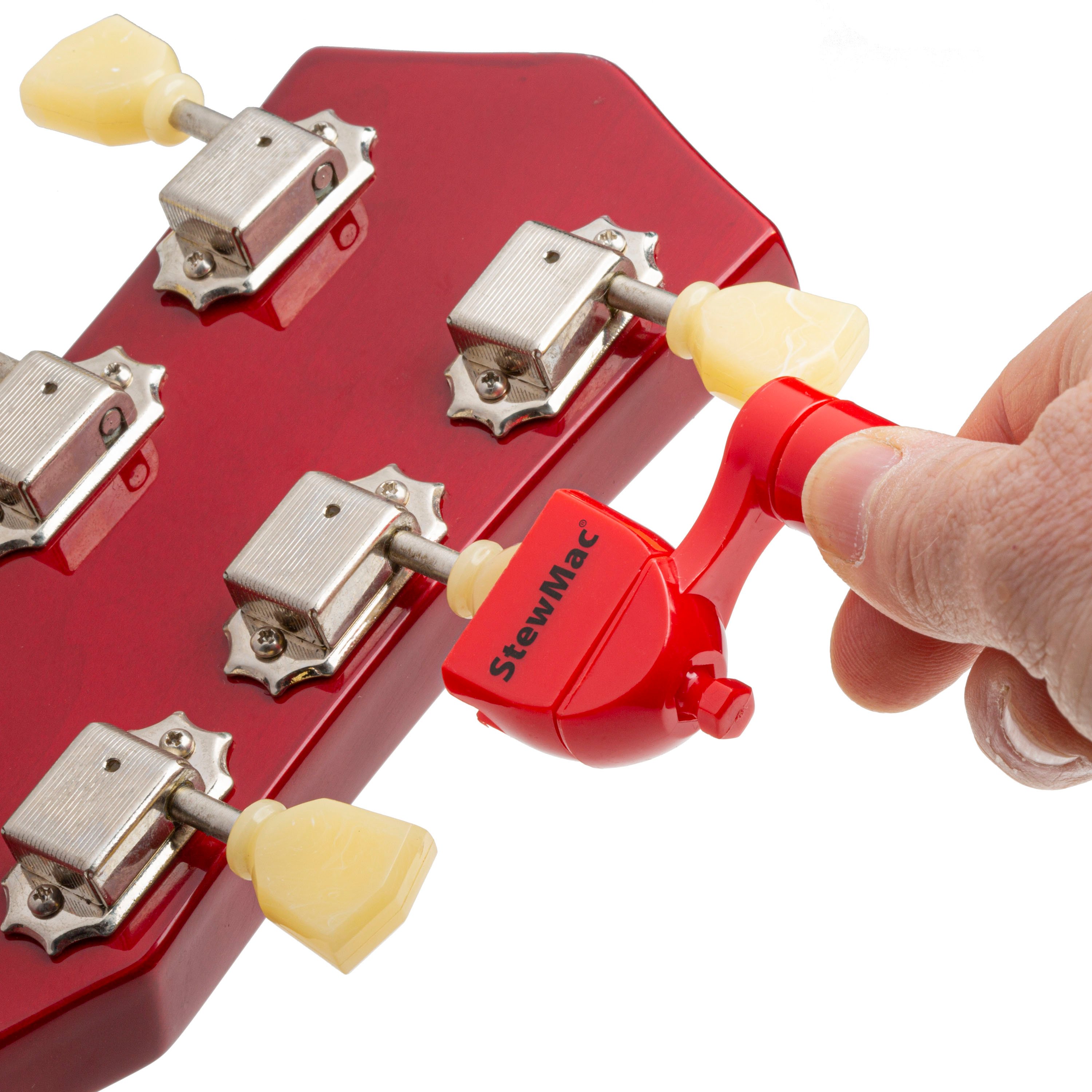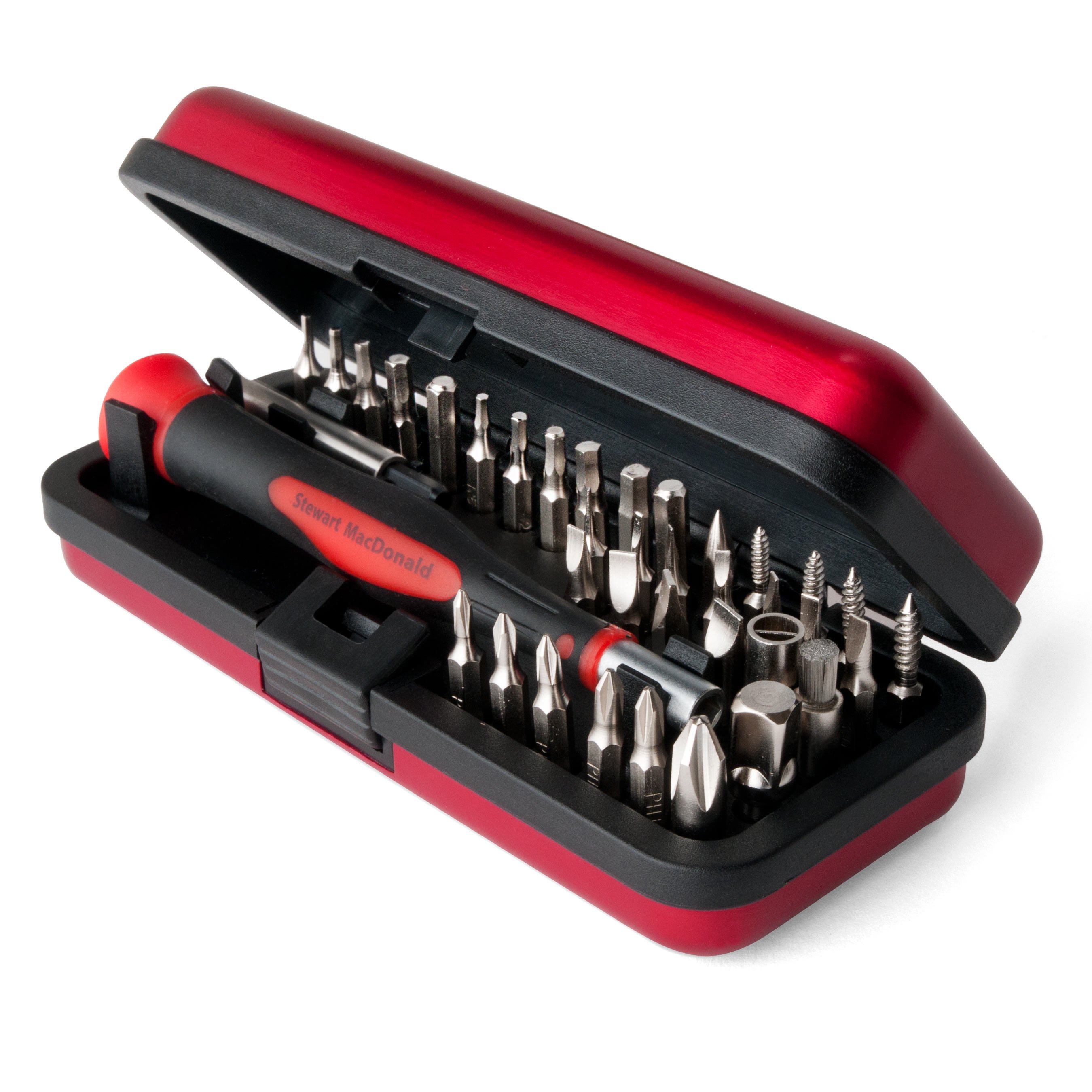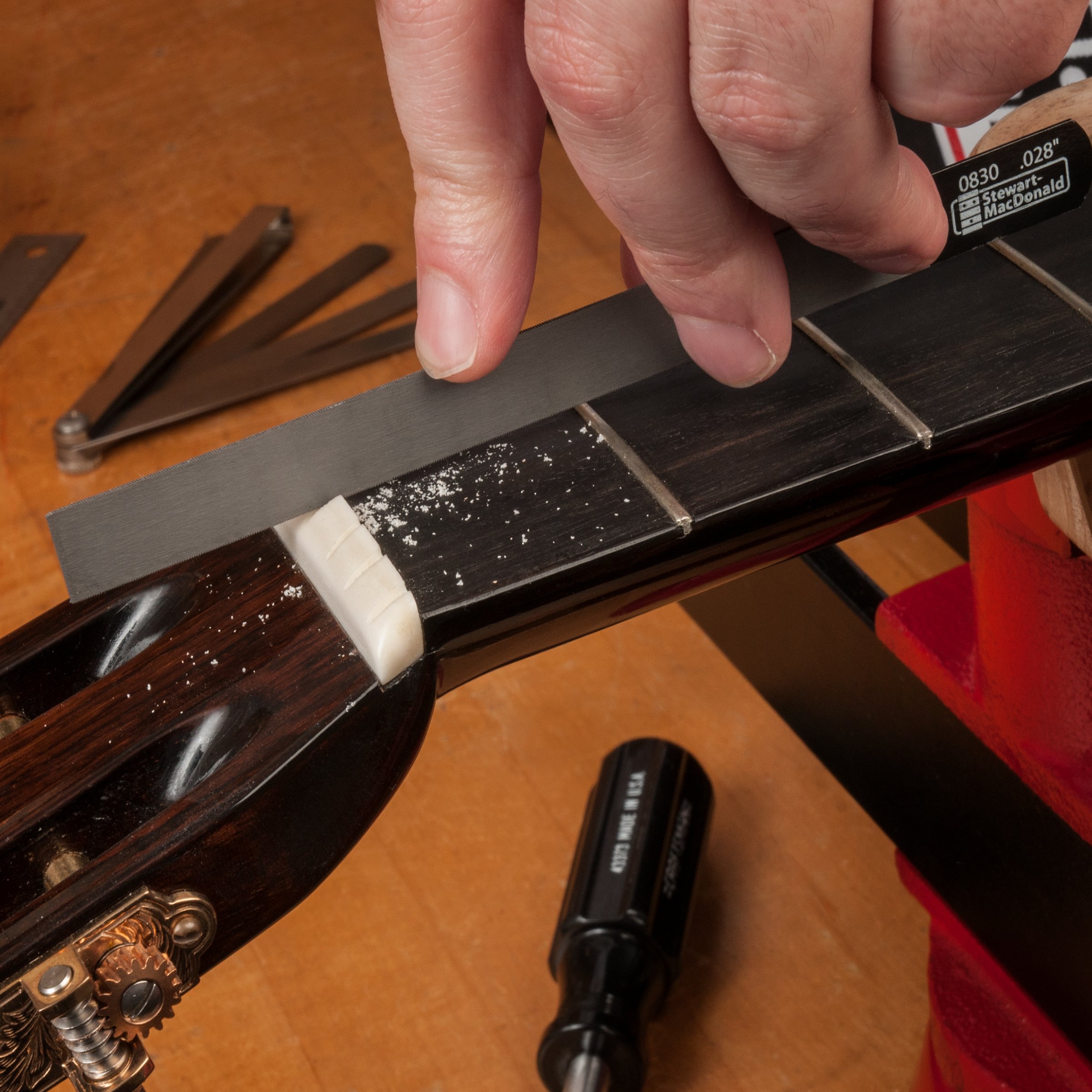5 Reasons Your Guitar Won't Stay In Tune
Do you have problems keeping your guitar in tune? Before you think about swapping out your tuners, check out this video. StewMac guitar tech Gene Imbody shows you five of the most common tuning issues—and how to fix them.
Video Transcription
[on-screen text reads: Gene - StewMac Tech]
Gene Imbody: Getting your guitar in tune and more importantly, keeping your guitar in tune, is something all guitars struggle with at some point. But before you go out and spend a bunch of money on fancy new tuners, check out this video because I'm going to give you five of the most common reasons your guitar might not be holding tune. And spoiler alert, none of them have to do with buying new tuners. And if you stick around until the end, I'm going to throw in a bonus tip that not only will help you with tuning, but it's going to make you a better player too.
Problem #1: The strings
The first thing I check when customers tell me they're having trouble keeping their guitar in tune is how they've wound the string to the post. This is critical. If you haven't installed your strings correctly, it's guaranteed you're not going to stay in tune. In most cases, you don't have to get locking tuners to make sure your strings don't slip on the post, and god forbid, don't tie any knots. You don't need to do any fancy tricks. A tuner post is engineered to hold your strings in place with a simple wind. There's several ways to do it well, but the simplest always works best for me. Insert the string through the post hole and give yourself a few inches of slack for the winds. Use a string winder to give yourself about half a wrap. Not nearly enough by any measure, but check this out. Even with just half a wrap, I can pretty much pick this guitar up by this thin string. As long as I keep tension on it, it's locked into place.
All you need from this point on is several neat wraps, three to four on the wound strings and four to six on the unwound, one after another, heading downward toward the peghead. If you want some more help with changing your strings, check out this video. We'll give you some added detail and even more helpful tips to help you along the way.
Another common reason strings won't hold tune is because they need to be stretched out properly. All new strings go through a stage where the metal stretches a little bit and the small amount of slack left in the winds needs to be pulled out. If you aren't in a hurry, you can just let that happen naturally, usually in a matter of hours with some tunings and retunings. But if you want them to stay in tune fast, you can use your hand or this cool little string stretching device we sell to help them out [on-screen text reads: The String Stretcha]. Give them all a gentle pull up and down the length of the string, retune and repeat. You'll know you're there when you stretch, check on your tuner, and you're still in tune or pretty close to it.
Problem #2: The tuners
The tuners and the bridge are your two anchor points of the string. They need to be totally stable or you're not going to stay in tune. So first off, make sure your mounting hardware is tight. Check your knob screws if you have them, the mounting screws, if you have threaded bushing tuners, make sure they're snug too. I like the spanner wrench for the bushings. It fits any size and it allows you to tighten them while the strings are in place.
Now in my experience, the tuners get way too much of the blame for tuning issues. Like I said, if you've installed the strings properly and all your hardware is tight, you should be good to go, no matter what quality tuners you have. A more likely issue that you may be having with your tuners is that you're not tuning correctly. You need to be tuning up to pitch, not down to pitch, like this.
Start a little flat and then tighten the tension so you are coming up to the note. If you've gone past your target, tune back down and then come up again. The reason you do this is because there may still be some slack in the gear or in the string, and that can cause you to continue to drift flat a little bit. This isn't a big deal with modern high quality tuners. The best tuners can go both directions, but it's a good habit to get into. And if you have vintage tuners, this is critical in my opinion.
Problem #3: The bridge
As I mentioned, you have two anchor points to a string that need to be completely stable. The bridge, or your tailpiece or vibrato, whatever you have, wherever the ball ends seat is that second anchor. In the case of a fixed bridge guitar, like a Fender Telecaster or a Gibson with a tune-o-matic, that means nothing can move. Screws need to be tight, bushings need to be seated well and stationary. I like to check pretty much anytime I change the strings, check out this Les Paul. With the strings off, I can make sure there's no looseness to the fit of the posts or the bushings. If anything is leaning or wobbling, that's a major problem. Holes can be plugged and redrilled, but that can be tricky. So you may want to consult a repair shop for that type of work.
Same for a Telecaster or a Hardtail Strat. It's always a good idea to check your mounting screws. If these screws won't tighten properly, the holes can be plugged and redrilled, like I mentioned earlier, fortunately these aren't super common issues. If you have a guitar with an archtop style tailpiece or a Bigsby vibrato, check your screws there periodically as well. And if you have a bolt-on neck, you guessed it, check those screws.
You want to be aware of the condition of any part of the guitar that directly supports the pull of the strings. Now it gets a little more complex when dealing with the Tremolo, since that's a moving system. The key there is to make sure the Trem claw screws are solid. They need to grab well and not feel loose in their holes. Same with the mounting studs, like the posts on a Gibson, they shouldn't lean wobble or pull out. Past that, the Trem should move smoothly and it should return to the same position when you release it. We'll get into the details of setting up a guitar with a Tremolo in another video. Just keep in mind that if you have a Trem, that's certainly going to affect your tune.
Problem #4: Intonation
Intonation refers to how accurately your guitar plays in tune as you move up the neck, you must be properly intonated for your guitar to play in tune to its full potential. You do this by making small adjustments to the length of your string through your saddles. You move your saddle back to make your string more flat, move your saddle forward to make the string more sharp.
Here's how most people check to make sure their guitar is properly intonated. Play your open note. Check the fretted 12th note. These two notes should match. If they don't, make small adjustments to the saddle, retune and check again. A lot of people think this is something only a tech can do, but if you're patient and you have a good tuner, this is absolutely something you can do yourself. Check out this link right here to watch our video dedicated to intonation and you'll have it down [on-screen text reads: How to Intonate Your Guitar].
One thing I want to point out, and this is really important, you're never going to be perfectly intonated in every spot on the board. For anyone who's ever intonated a guitar, you may have been in this situation. You're perfectly in tune at the 12th fret, but you have some other spots on the board with sour notes, particularly in the first position on your open chords, sometimes referred to as cowboy chords. You may have assumed there was something else wrong with your guitar, but like I said, the guitar is an imperfect instrument. There are always going to be some notes along the way that are going to be a little bit out of tune.
The idea behind intonation is to spread the error out so that not any one spot is any more out of tune than any other. What I tend to find is that sharp notes are very offensive to the ear. Flat notes not quite as much. So if I do find some overly sharp notes in the first position, I'll move my saddles even further back to help correct that. That usually means being a little bit flat at the 12th fret. But that doesn't bother me nearly as much as the sharp notes in the first position. The point I want to convey here is to not be so caught up with the fact that you need to be perfect at the 12th fret, you can set your intonation to correct the problems wherever they bother you the most.
Problem #5: The nut
Believe it or not, most tuning issues come down to the nut. Do not go spend a bunch of money on fancy new tuners until you make sure you have a properly functioning nut. First off, the slots in the nut have to be at the right height. The further you have to stretch the string to touch the fret, the sharper the note is going to be and the harder it will be to intonate the guitar.
So how do you know if your nut is at the right height? Well we have a lot of tools that can help you with this, but let me see if I can simplify it for you. Think of the nut as a fret that's always fretted, like a zero fret. Much in the same way that the first fret doesn't need to be any higher than the second fret when your fret notes there, and the second fret doesn't need to be any higher than the third fret when your fret notes there. Theoretically, the height of the strings over the first fret shouldn't need to be any higher than the height of the strings over the second fret when you're fretted at the first.
What? Now that's a mouthful. So let's take a look at it. Put a capo at the first fret and look at the height of the strings over the second on this guitar. You can measure this height with Feeler Gauges or even a guitar string bent at a right angle. Now I can tell you from experience, open strings tend to move more. People tend to strike open notes harder. So take that measurement and double it [Gene writes .010" x 2 = .020" on a notepad]. That's the height you want to see from the top of the first fret to the bottom of the string. It's a little extra insurance to make sure you're not going to buzz.
I can see on this guitar that the height of my string over the first fret is more than double what it was on the second fret. I'm going to move the string and use a nut file to lower it a little bit. Then we replace the string and check it again. Go slowly and repeat that until you are where you need to be. Now be careful, if you lower the slot too much, you could end up buzzing and then you might have to replace the whole nut.
Ah!
Now let's talk about the biggest culprit I see for tuning issues. Have you ever tried tuning your string and noticed that nothing's happening right at first and then suddenly you're sharp or flat of where you were trying to be? Here's what's happening. The nut slot, usually at the back where the strings leave the tuners and enter the nut slot at an angle, is pinching the strings and not allowing them to move freely. So how do you fix this? You need to reshape the slots so they don't impede the movement of the strings. The first place to concentrate is the back of the slot where the strings enter. We're going for something that looks like a funnel that has been cut in half. Gauged nut files are best for this, but if you don't have those, you can use folded sandpaper, sanding cord, or a very small half round or V-shaped needle file.
I'm flaring out the back edge so that the entry angle of the string doesn't catch on the corners. I like to hit both sides. Roll the file as you relieve the edges and add some angle to the bottom of the slot to create a bit of a ramp towards the front edge. If your nut action is good, be sure you're staying off the very front of the slot, or you will also lower the height of the strings. After you've done your shaping, go back with high grit sandpaper to smooth everything out, I fold up 600 and a thousand grit to get something close to the diameter of the string I'm working on. It's not a bad idea when you're done shaping to use a string of the same gauge to floss the slot. What I'm checking for here is to make sure that the string wants to move through without grabbing.
So I started with the D and the G because those are the two worst culprits on a three left, three right peghead, because of that angle coming into the back of the slot. But I'll hit all six strings the same. I might exaggerate the funnel a little bit on those, but each one of them will get the same treatment. The last thing to consider is how deeply the strings are buried in the slots. If there's too much material above the string, this can hang them up as well. I like to shoot for half the depth of the wound strings and to just feel the tops of the unwound strings. These strings are clearly sitting way too deep into the nut, so let's fix that. You can do this right on the guitar, but be sure to tape off and protect your finish. If your nut comes out easily, go ahead and remove it and do this work in a vice.
All I do is use our nut shaping files or a radius block to remove the excess from the top and expose some strings. Don't go too far, leave yourself a little extra to sand out the scratches and polish when you're done. Now the one thing I'll say is if you have an inexpensive guitar with a plastic nut, you might just consider having it replaced. I like bone the best, but really plastic is too soft to be doing this kind of work too.
Bonus Tip!
So I said I was going to give you a bonus tip to help with your tuning and make you a better player, so here it is. Improving the ability of your guitar to stay in tune is a matter of controlling variables. And the biggest variable is you, the player. The better your technique and the lighter your touch, the more your guitar will play in tune. If you have a death grip on your fretting hand, learn to relax. If you have a wild out of control picking hand, practice precision. And finally, train yourself to tune by ear. Treat your ear like a muscle and exercise it. Practice using a tuning fork and identifying pitch. Electronic tuners definitely have their place, but make sure it's a tool, not a crutch. If you're able to trust your ear, you'll be a better repair person and a better player.






